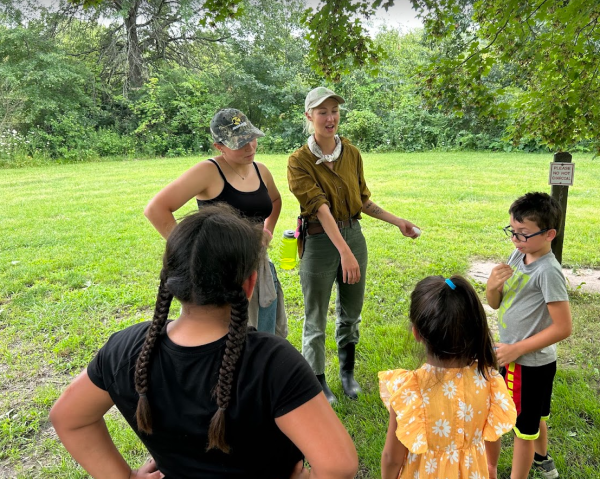
Adventures in Conservation – CLIP 2024 Week 9
Hello all and welcome to week 9! This week’s blog is written by CLIPtern Gia.
We started out this Monday at Apple Creek targeting all kinds of invasive species such as parsnip, giant ragweed, sweet clover, sow thistle, and mares tail. On top of this we collected some birdsfoot trefoil seed heads. After a successful day spent at Apple Creek we were ready for Tuesday’s endeavors.
Tuesday was dedicated to our research project about how incidental herbicide application will affect the viability of native plants. Throughout the program we have been watering our test plants in order to help them grow before applying herbicide (which will be less concentrated in order to allow our plants to not completely die within the time it takes for the herbicide to take effect). A good chunk of our day was spent grinding out the nitty gritty of this project- things such as beginning to type our research paper, creating tables and graphs, and solidifying what to look for once we spray our plants in the coming days so we can have concise results of what happened as herbicide application increased among test groups.
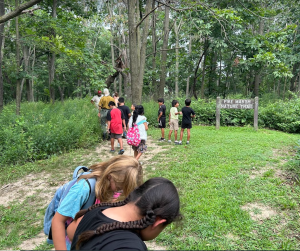 After using a good amount of our brain power for the day, we headed to Moraine Hills State Park to teach a nature lesson on good bugs versus bag bugs and their bug jobs for the Youth and Family Center of McHenry County (YFC)! Here, we split the group in two where half of them went on a bug hunt hike and the other half received a short lesson on bugs then got to paint a rock! The YFC kids learned about different bugs such as a “good bug” or a monarch butterfly whose bug job is to pollinate while “bad bugs” such as a japanese beetle are bad because they destroy plants. At the end of each activity they switched and we could tell the kids loved exploring Moraine Hills and expressing their creativity!
After using a good amount of our brain power for the day, we headed to Moraine Hills State Park to teach a nature lesson on good bugs versus bag bugs and their bug jobs for the Youth and Family Center of McHenry County (YFC)! Here, we split the group in two where half of them went on a bug hunt hike and the other half received a short lesson on bugs then got to paint a rock! The YFC kids learned about different bugs such as a “good bug” or a monarch butterfly whose bug job is to pollinate while “bad bugs” such as a japanese beetle are bad because they destroy plants. At the end of each activity they switched and we could tell the kids loved exploring Moraine Hills and expressing their creativity!
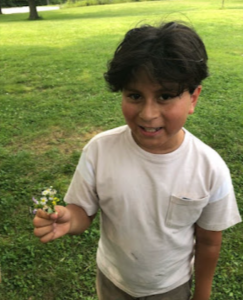
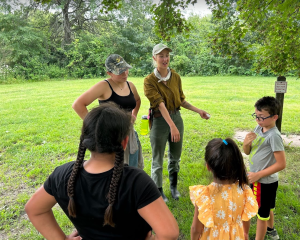
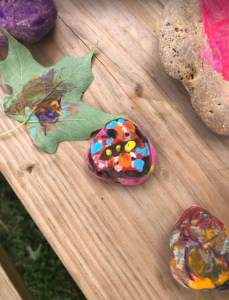
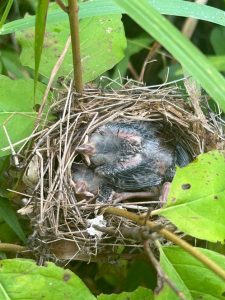 The next day we headed to Yonder Prairie Nature Preserve to spray some resprouts in the morning with our handy dandy herbicide backpacks filled with Triclopyr. We targeted resprouts such as buckthorn (rhamnus cathartica) and oriental bittersweet (celastrus orbiculatus). At the very end of spraying we discovered a bird’s nest with some very cute baby birds! Afterward, we attended a career panel where we heard from insightful individuals about what they do in the field, how they got to their point in the field, their previous experience, advice they had, and we got to ask plenty of questions. We learned about a range of careers from working for the Chicago Botanical Garden’s Plants of Concern program to working for the EPA measuring water quality. We really appreciated the different perspectives and advice each person had to offer and hope to put it to good use going forward!
The next day we headed to Yonder Prairie Nature Preserve to spray some resprouts in the morning with our handy dandy herbicide backpacks filled with Triclopyr. We targeted resprouts such as buckthorn (rhamnus cathartica) and oriental bittersweet (celastrus orbiculatus). At the very end of spraying we discovered a bird’s nest with some very cute baby birds! Afterward, we attended a career panel where we heard from insightful individuals about what they do in the field, how they got to their point in the field, their previous experience, advice they had, and we got to ask plenty of questions. We learned about a range of careers from working for the Chicago Botanical Garden’s Plants of Concern program to working for the EPA measuring water quality. We really appreciated the different perspectives and advice each person had to offer and hope to put it to good use going forward!
Thursday we met with Lisa Haderlein, the Executive Director of TLC, who gave us a workshop on resumes and some insight on how to make your resume appeal to your employer. In this workshop we got to critique each other’s resumes and help each other give our resumes the boost it needed! Lisa also gave us lots of great tips about how to write a cover letter and what can make or break your resume.
After editing our resumes we made our way back to Apple Creek to monitor for any violations such as dumping or sign damage, as well as taking note of plants within the easements. To do this successfully, we split up into groups of two to check each site within Apple Creek in a timely manner. Any violations were documented and then compiled for a report. On our way back from Apple Creek we stopped by Kishwaukee Headwaters to sample a few plants for our books to identify. We collected compass plant, prairie dock, New England aster, and Queen Anne’s lace.
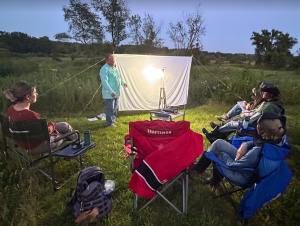 Before heading off to our final event of the night we met with TLC board member Randy Schietzelt at Napoli’s Pizza in Woodstock for a group dinner! After a great time at Napoli’s we headed to Yonder to do our insects at night workshop with Randy! We set up a white sheet to help us see the insects with a light in front of it to attract them. Unfortunately, we only got smaller insects and only one or two bigger insects such as a green darter dragonfly. Since we weren’t having much luck we decided to test a theory that if you shine a flashlight on a tree at night you’ll see caterpillars. We debunked this theory only finding one caterpillar that was not on a tree. Nonetheless, we still had a great time!
Before heading off to our final event of the night we met with TLC board member Randy Schietzelt at Napoli’s Pizza in Woodstock for a group dinner! After a great time at Napoli’s we headed to Yonder to do our insects at night workshop with Randy! We set up a white sheet to help us see the insects with a light in front of it to attract them. Unfortunately, we only got smaller insects and only one or two bigger insects such as a green darter dragonfly. Since we weren’t having much luck we decided to test a theory that if you shine a flashlight on a tree at night you’ll see caterpillars. We debunked this theory only finding one caterpillar that was not on a tree. Nonetheless, we still had a great time!
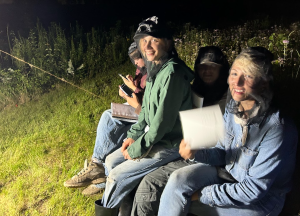
Finally on Friday we were back to targeting invasives with our trusted and beloved herbicide backpacks. We first targeted teasel at the Clark easement with Milestone. Before spraying we cut down the teasel heads and bagged them to prevent any more from germinating, then proceeded to spray all of the teasel before heading to our next and final stop of the week, which was the Remington easement. Here, we targeted and pulled sweet clover and collected some birdsfoot trefoil. At the end of the day we brought back all of our bags we had collected and put them on the burn pile.
That was week nine! We cannot believe we only have two more weeks left of CLIP. Our knowledge of ecology and conservation has grown so much since May and we’re excited to put it to use outside of CLIP! See you next week!